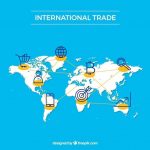
In today’s interconnected and dynamic global economy, businesses face a myriad of challenges and opportunities when venturing into international markets. The ever-evolving landscape of trade presents a complex web of obstacles that require astute navigation and strategic decision-making. From regulatory hurdles to cultural differences, companies must be equipped with the right knowledge and tools to thrive in this competitive arena.
One of the key challenges businesses encounter in international trade is the intricate web of regulations and policies that govern cross-border transactions. Each country has its own set of rules and regulations, ranging from import and export restrictions to customs procedures. Navigating through this maze of bureaucracy requires a deep understanding of international trade laws and the ability to adapt to ever-changing policies.
Furthermore, cultural differences and language barriers pose significant challenges for businesses operating in international markets. Understanding the nuances of different cultures is crucial for establishing successful business relationships and avoiding potential misunderstandings. Effective communication, both verbal and non-verbal, plays a vital role in building trust and fostering long-term partnerships.
Despite these challenges, international trade also presents immense opportunities for businesses to expand their reach and tap into new markets. By venturing beyond domestic borders, companies can access a larger customer base and diversify their revenue streams. Moreover, globalization has facilitated the exchange of ideas and technologies, enabling businesses to benefit from innovation and expertise from around the world.
In conclusion, the world of international trade is a complex and multifaceted arena that demands careful navigation and a deep understanding of the challenges and opportunities it presents. By overcoming regulatory hurdles, bridging cultural gaps, and capitalizing on global markets, businesses can position themselves for success in the ever-evolving landscape of international trade.
Understanding the Complexities of International Trade Regulations
In the realm of global commerce, it is imperative for businesses to comprehend the intricate web of international trade regulations. These regulations, which govern the movement of goods and services across borders, present both challenges and opportunities for companies operating in international markets. A comprehensive understanding of these complexities is crucial for businesses to navigate the ever-evolving landscape of global trade.
The Multifaceted Nature of International Trade Regulations
International trade regulations encompass a wide range of legal frameworks, policies, and agreements that govern the exchange of goods and services between countries. These regulations are designed to ensure fair competition, protect intellectual property rights, promote safety standards, and regulate the flow of goods across borders. They are influenced by various factors, including political, economic, and cultural considerations, making them highly complex and dynamic.
The Impact on Businesses
Compliance with international trade regulations is not only a legal requirement but also a strategic imperative for businesses operating in global markets. Failure to adhere to these regulations can result in severe penalties, reputational damage, and even the loss of market access. On the other hand, businesses that successfully navigate the complexities of international trade regulations can gain a competitive advantage, access new markets, and establish strong relationships with international partners.
| Challenges | Opportunities |
|---|---|
| 1. Compliance with diverse and evolving regulations | 1. Access to new markets and customers |
| 2. Navigating complex customs procedures | 2. Enhanced credibility and trust with international partners |
| 3. Managing trade barriers and tariffs | 3. Potential for cost savings through preferential trade agreements |
| 4. Understanding and mitigating risks associated with international trade | 4. Opportunities for innovation and diversification |
Given the intricacies of international trade regulations, businesses must invest in robust compliance programs, engage in ongoing monitoring and risk assessment, and seek expert advice when necessary. By doing so, they can effectively navigate the complexities of international trade regulations and seize the opportunities presented by global markets.
Overcoming Language and Cultural Barriers in Global Business
In today’s interconnected world, businesses are increasingly expanding their operations across borders to tap into new markets and opportunities. However, this expansion comes with its own set of challenges, particularly when it comes to language and cultural barriers. Effective communication and understanding of cultural nuances are crucial for successful business interactions in international markets.
Language Barriers
One of the primary obstacles in global business is the language barrier. Language differences can hinder effective communication, leading to misunderstandings, misinterpretations, and even failed business deals. It is essential for businesses to overcome this challenge by implementing strategies to bridge the language gap.
One approach is to hire bilingual or multilingual employees who can serve as interpreters or translators during business negotiations. These individuals can facilitate communication between parties and ensure that messages are accurately conveyed. Additionally, businesses can also invest in language training programs for their employees to enhance their language skills and improve cross-cultural communication.
Cultural Barriers
Cultural differences can also pose significant challenges in global business. Each culture has its own set of values, norms, and customs, which can influence business practices and decision-making processes. Failing to understand and adapt to these cultural nuances can lead to misunderstandings, offense, and ultimately, the loss of business opportunities.
To overcome cultural barriers, businesses should invest in cultural awareness and sensitivity training for their employees. This training can help individuals develop a deeper understanding of different cultures, enabling them to navigate cultural differences with respect and adapt their business strategies accordingly.
| Benefits of Overcoming Language and Cultural Barriers |
|---|
| 1. Enhanced communication and understanding between business partners |
| 2. Increased trust and credibility in international markets |
| 3. Improved negotiation and conflict resolution skills |
| 4. Access to a wider range of business opportunities |
| 5. Strengthened relationships with international clients and partners |
In conclusion, overcoming language and cultural barriers is essential for businesses operating in international markets. By investing in language training, hiring bilingual employees, and promoting cultural awareness, businesses can navigate these challenges and unlock the vast opportunities that global trade offers.
Managing Supply Chain Risks in International Trade
In the realm of conducting business on a global scale, it is crucial for companies to be aware of and effectively manage the risks associated with their supply chains. The interconnectedness of international markets presents both challenges and opportunities, making it essential for businesses to navigate the complexities of supply chain management in order to thrive in the global trade landscape.
Understanding the Complexity of International Supply Chains
International trade involves a multitude of interconnected processes, from sourcing raw materials to manufacturing, transportation, and distribution. Each step in the supply chain introduces its own set of risks, such as delays, disruptions, quality issues, and compliance challenges. These risks can have significant impacts on a company’s ability to deliver products to customers in a timely and cost-effective manner.
Effective Risk Assessment and Mitigation Strategies
In order to effectively manage supply chain risks in international trade, businesses must first conduct a comprehensive risk assessment. This involves identifying potential risks at each stage of the supply chain and evaluating their likelihood and potential impact. By understanding the specific risks they face, companies can then develop appropriate mitigation strategies to minimize the impact of these risks.
One key aspect of risk mitigation is diversifying the supply chain. By sourcing materials and components from multiple suppliers and countries, companies can reduce their dependence on a single source and mitigate the risk of disruptions caused by geopolitical events, natural disasters, or other unforeseen circumstances.
Building Resilience through Collaboration and Technology

Collaboration with suppliers, logistics providers, and other stakeholders is essential in managing supply chain risks. By fostering strong relationships and open lines of communication, companies can gain valuable insights into potential risks and work together to develop contingency plans. Additionally, leveraging technology solutions such as real-time tracking systems, data analytics, and predictive modeling can provide companies with the visibility and agility needed to respond quickly to disruptions and minimize their impact.
Investing in supply chain resilience not only helps companies mitigate risks but also provides a competitive advantage. By building a robust and adaptable supply chain, businesses can better navigate the challenges and seize the opportunities presented by international trade.
In conclusion, managing supply chain risks in international trade is a critical aspect of conducting business in the global marketplace. By understanding the complexity of international supply chains, implementing effective risk assessment and mitigation strategies, and building resilience through collaboration and technology, businesses can navigate the challenges and capitalize on the opportunities that arise in international markets.
Leveraging Technology for Efficient Global Trade Operations
In today’s interconnected world, businesses face numerous challenges and opportunities when it comes to engaging in international markets. One key aspect that can significantly impact the success of global trade operations is the effective utilization of technology.
By harnessing the power of technology, businesses can streamline their operations, enhance efficiency, and overcome various obstacles that arise in the complex landscape of international trade. Technology serves as a catalyst for innovation, enabling businesses to adapt to changing market dynamics and capitalize on emerging opportunities.
One of the primary benefits of leveraging technology in global trade operations is the ability to automate processes. Automation reduces manual errors, increases accuracy, and saves valuable time and resources. Through the use of advanced software solutions, businesses can automate tasks such as inventory management, order processing, and logistics, ensuring smooth and seamless operations across borders.
Furthermore, technology facilitates real-time communication and collaboration, breaking down geographical barriers and enabling businesses to connect with partners, suppliers, and customers around the world. With the advent of digital platforms, businesses can engage in virtual meetings, negotiate contracts, and exchange vital information instantaneously, fostering stronger relationships and driving faster decision-making processes.
Another significant advantage of leveraging technology is the access to vast amounts of data and analytics. Through sophisticated data analysis tools, businesses can gain valuable insights into market trends, consumer behavior, and competitor strategies. This information empowers businesses to make informed decisions, optimize their supply chains, and identify new market opportunities, ultimately driving growth and profitability.
Moreover, technology plays a crucial role in ensuring compliance with international regulations and standards. With the ever-evolving regulatory landscape, businesses need to stay updated and adhere to various legal requirements. Technology solutions provide businesses with the necessary tools to monitor and manage compliance, reducing the risk of penalties and reputational damage.
In conclusion, leveraging technology is essential for businesses aiming to thrive in international markets. By embracing automation, enhancing communication, utilizing data analytics, and ensuring compliance, businesses can achieve efficient global trade operations, seize opportunities, and overcome challenges in the dynamic world of international trade.
Identifying Emerging Markets and Expanding Business Opportunities

In the ever-evolving landscape of international business, it is crucial for companies to stay ahead of the curve by identifying emerging markets and seizing the opportunities they present. By recognizing the potential of these markets and strategically expanding their operations, businesses can tap into new customer bases, increase their revenue streams, and gain a competitive edge in the global marketplace.
Understanding the Concept of Emerging Markets
Emerging markets refer to economies that are experiencing rapid growth and development, often characterized by increasing levels of industrialization, urbanization, and consumer demand. These markets offer significant potential for businesses looking to expand their operations beyond traditional markets.
Factors to Consider when Identifying Emerging Markets
- Economic indicators: Analyzing key economic indicators such as GDP growth rates, inflation rates, and foreign direct investment can provide insights into the potential of a market.
- Demographic trends: Understanding the population size, age distribution, and income levels of a market can help businesses assess its consumer demand and purchasing power.
- Infrastructure development: Assessing the quality of infrastructure, including transportation, communication, and logistics networks, is crucial for determining the feasibility of entering a market.
- Political and regulatory environment: Evaluating the stability of the political system, government policies, and regulatory frameworks is essential to mitigate risks and ensure a favorable business environment.
By carefully considering these factors, businesses can identify emerging markets that align with their products or services and have the potential to generate sustainable growth and profitability.
Expanding business opportunities in emerging markets requires a comprehensive strategy that takes into account market entry barriers, cultural differences, and competitive landscapes. Companies must adapt their products, marketing strategies, and distribution channels to cater to the unique needs and preferences of consumers in these markets.
Furthermore, building strong relationships with local partners, distributors, and suppliers can provide businesses with valuable market insights, access to distribution networks, and help navigate the complexities of doing business in unfamiliar territories.
In conclusion, identifying emerging markets and expanding business opportunities is a vital aspect of navigating the global trade landscape. By understanding the concept of emerging markets, considering key factors, and implementing a well-rounded strategy, businesses can position themselves for success in international markets and capitalize on the potential for growth and profitability.
Building Strong Partnerships and Networks in International Markets
In today’s interconnected global economy, establishing strong partnerships and networks is crucial for businesses seeking success in international markets. Collaborating with like-minded organizations and individuals can provide numerous benefits, including access to new markets, shared resources, and valuable knowledge and expertise.
Creating strong partnerships involves finding compatible partners who share similar goals and values. These partnerships can be formed with other businesses, industry associations, government agencies, or even academic institutions. By working together, organizations can leverage each other’s strengths and overcome common challenges, ultimately increasing their chances of success in international markets.
Building a network of contacts is equally important. Networking allows businesses to expand their reach and tap into new opportunities. Attending industry conferences, trade shows, and business events can provide valuable networking opportunities, enabling businesses to connect with potential partners, customers, and suppliers from around the world.
When building partnerships and networks in international markets, it is essential to establish trust and foster open communication. Clear and transparent communication helps to build strong relationships and ensures that all parties are aligned in their objectives. Regular communication and collaboration can also help identify potential issues or opportunities early on, allowing for timely adjustments and strategic decision-making.
Furthermore, businesses should consider the cultural and linguistic aspects of their target markets when building partnerships and networks. Understanding and respecting cultural differences can help avoid misunderstandings and build trust with international partners. Additionally, having individuals within the organization who are fluent in the language of the target market can facilitate effective communication and relationship-building.
In conclusion, building strong partnerships and networks is a vital component of navigating international markets successfully. By collaborating with compatible partners, expanding networks, fostering open communication, and considering cultural aspects, businesses can enhance their chances of achieving sustainable growth and seizing opportunities in the global marketplace.

















+ There are no comments
Add yours